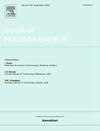介绍了用SCALE估计球床反应器平衡运行库存的SLICE方法
IF 2.3
3区 工程技术
Q1 NUCLEAR SCIENCE & TECHNOLOGY
引用次数: 0
摘要
本文介绍了利用SCALE代码系统的功能估算球床反应堆平衡堆芯同位素清单的SCALE跃进法(SLICE),该方法只需要一个小的计算集群和几天的计算时间。该方法使用了一种迭代方法,该方法依赖于(1)捕获空间和时间相关光谱条件的替代光谱模型,(2)捕获作为核心位置和时间函数的卵石核素库存演变的多通道模型,以及(3)捕获核心空间中子通量分布的全核心模型。SLICE方法应用于通用氟化物盐冷却高温反应堆,通过迭代核素浓度检查和不同离散化堆芯实现的比较,展示了燃料库存收敛性。结果与另一种最先进的代码的一致性在~ 5%以内,差异归因于平衡生成方法中的输入参数或建模假设的变化。本文章由计算机程序翻译,如有差异,请以英文原文为准。
Introducing the SLICE Method for estimating pebble-bed reactor inventories at equilibrium operation with SCALE
This paper introduces the SCALE Leap-In method for Cores at Equilibrium (SLICE) for estimating pebble-bed reactor equilibrium core isotopic inventories using capabilities in the SCALE code system, requiring only a small computational cluster and a few days of computation. This method uses an iterative approach that relies on (1) a surrogate spectrum model that captures spatial and time-dependent spectral conditions, (2) a multi-pass model that captures the pebble’s evolving nuclide inventory as a function of location and time in the core, and (3) a full-core model that captures the core’s spatial neutron flux distribution.
The SLICE approach is applied to a generic fluoride salt–cooled high-temperature reactor, demonstrating fuel inventory convergence through nuclide concentration inspection across iterations and comparisons for core realizations with varying discretizations. Results agree within 5% with another state-of-the-art code, with differences attributed to input parameter or modeling assumption variations in the equilibrium generation methods.
求助全文
通过发布文献求助,成功后即可免费获取论文全文。
去求助
来源期刊

Annals of Nuclear Energy
工程技术-核科学技术
CiteScore
4.30
自引率
21.10%
发文量
632
审稿时长
7.3 months
期刊介绍:
Annals of Nuclear Energy provides an international medium for the communication of original research, ideas and developments in all areas of the field of nuclear energy science and technology. Its scope embraces nuclear fuel reserves, fuel cycles and cost, materials, processing, system and component technology (fission only), design and optimization, direct conversion of nuclear energy sources, environmental control, reactor physics, heat transfer and fluid dynamics, structural analysis, fuel management, future developments, nuclear fuel and safety, nuclear aerosol, neutron physics, computer technology (both software and hardware), risk assessment, radioactive waste disposal and reactor thermal hydraulics. Papers submitted to Annals need to demonstrate a clear link to nuclear power generation/nuclear engineering. Papers which deal with pure nuclear physics, pure health physics, imaging, or attenuation and shielding properties of concretes and various geological materials are not within the scope of the journal. Also, papers that deal with policy or economics are not within the scope of the journal.
 求助内容:
求助内容: 应助结果提醒方式:
应助结果提醒方式:


